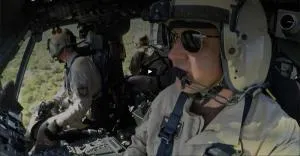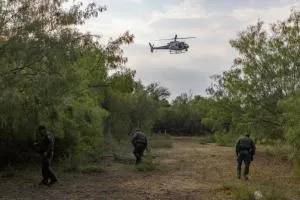During the COVID-19 epidemic, CBP’s Air and Marine Operations crews create social distance … and more chances to intercept the bad guys
Social distancing is the key message in these days of coronavirus: going out no more than what is absolutely essential and staying at least six feet away from people when you do. For the men and women of Air and Marine Operations — the component of U.S. Customs and Border Protection which operate helicopters and planes and command boats — to conduct their mission of interdicting drugs and illegal entrants, remains essential, especially along the Southwest border. And they’re not afraid of getting up-close-and-personal in the smugglers’ business, even if it’s from a safe distance.

Interdiction Agent Shawn Jones from the McAllen Air
Branch conduct patrol operations in a UH-60 Black
Hawk helicopter near Mission, Texas.
Photo by Rod Kise
“The bad guys never let a crisis go to waste. They’re always trying to find ways to exploit weaknesses in our defense,” said Keith Jones, executive director, Air and Marine Operations, Southwest Region, an area of the U.S.-Mexico border that stretches nearly 2,000 miles and covers the rivers, deserts and sea waters between the two countries from the Gulf of Mexico to the Pacific Ocean. “Our folks are going out there and stepping up every day, working with [Border Patrol and Field Operations] folks on the ground.”
To make sure no one does take advantage of the COVID-19 crisis, flights along the Southwest border, including its maritime approaches, increased since much of the social distancing and isolation started a few weeks ago. Jones said that’s actually been a product of one of the ways his division implemented social distancing at work: spreading personnel more broadly across the 24-hour workday and seven-day calendar week, creating distance between crews. The added distance between crew members permits greater use of limited assets, and thus, more flights. In fact, compared to just before those policies went into effect, Air and Marine Operations increased flight hours along the Southwest border by nearly 15%.
The extra time in the air makes for a difference not lost on the people who work those flights, such as Supervisory Aviation Enforcement Agent Lonnie Smith, who flies out of McAllen, Texas, and spends his day conducting surveillance from the air and coordinating with Border Patrol agents on the ground.
“We’re actually able to increase our footprint,” Smith said. “Not only at the office and mitigate people working in close proximity [with each other], but also creating more of a footprint out there on the line adding additional layers of coverage.”

from the McAllen Air Branch works with Border Patrol
agents tracking a group near Penitas, Texas.
Photo by Rod Kise
At the McAllen Air Branch, they’ve ended up adding two more shifts, which means an extra 40 hours of flying each week. While encounters with illegal entrants are at a historical low, this allows the crews he flies with to focus on the narcotics trade, without illegal immigration giving smugglers cover. But they’re ready if illegal immigration and the drug trade kicks back into high gear. “We’re postured in a position to mitigate any kinds of threats that may start to bombard the river (Rio Grande) area,” Smith said.
All the way across the country in California, Marine Interdiction Agent Benjamin Lowe climbed aboard the 41-foot Coastal Interceptor Vessel that will take him and the boat’s crew out on the waters to patrol the Pacific Ocean where Mexico and the United States meet.
“We have eyes everywhere, and we can track vessels a little bit easier than we normally could,” before the COVID-19 restrictions went into effect, Lowe said. Plus, with fewer boats out there to watch and more patrols to watch them, it’s easier for one boat crew to hand off a monitored subject to another Air and Marine Operations crew further up the coast. For example, they don’t have to drive their vessel north from San Diego to Oceanside, California, a trip that would normally take about an hour of pounding on the Pacific Ocean swells. “Now, we don’t even need to make that transit because we know there are agents up there.”
Lowe said they’ve also noticed lower numbers of boats out on the water, as pleasure boats and fishermen have had to cut back on their operations. He said that does help them sort out which boats are legitimate and which ones are potential smugglers.
“We work in conjunction with camera sensor operators, so for them with less vessel traffic, it’s easier for the sensor operators to spot boat traffic and notify us to interdict those vessels,” Lowe said.
But he noted that doesn’t mean they’re getting relaxed in their security posture, keeping sharp eyes open.
“We still have to do our job; we still have to look through the vessel if there’s some kind of border nexus,” Lowe said. “The protection of the country is No. 1. And we’re going to do [our job] as safely as we can.”

Interceptor Vessel operates in the Pacific Ocean.
Photo by Mani Albrecht
Meetings – what law enforcement officers call “musters” – and the all-important intelligence and weather briefings are being conducted virtually to help promote social distancing efforts. Jones said making sure his workforce stays healthy is at the front of his mind.
“Because of the nature of this unprecedented pandemic, the safety of our people was first and foremost, so we changed our operations to accommodate an increased level of safety for our folks,” holding those virtual musters and changing schedules to increase social distancing for aircrews, which in turn, resulted in the extra flight hours, he said.
Jones was also quick to point out the close cooperation between Air and Marine Operations agents and the men and women of Border Patrol and Office of Field Operations. “[People] are on the frontlines, coming to work every day, putting themselves in harm’s way, and I just want to express my appreciation,” he said.
In a time when each day is a trip into uncharted territory, Jones actually sees some benefits about what the current crisis is teaching the men and women of Air and Marine Operations along the Southwest border, and CBP as a whole.
“It demonstrates how CBP, collectively, has come together in the face of this crisis, and we’re demonstrating success in managing our ports of entry, and we’re managing what goes on between our ports of entry, all doing it as a team,” Jones said. “It brings to light what border security means to the health, safety and economic prosperity of our country. It’s critical.”

